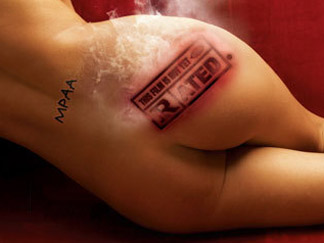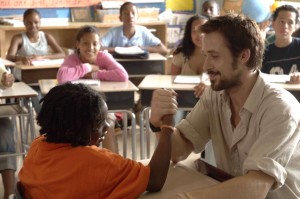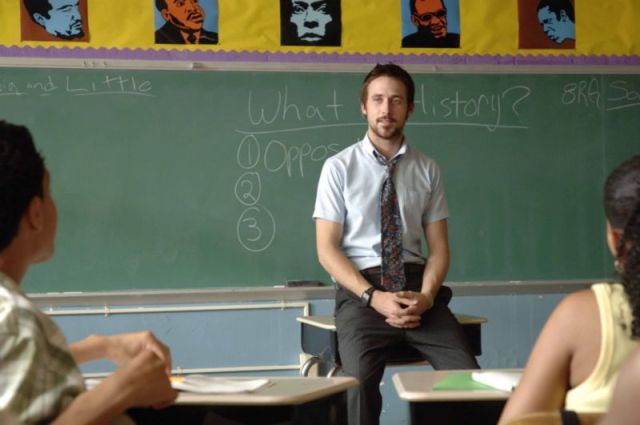From the Chicago Reader (September 15, 2006). — J.R.
Half Nelson
**** (Masterpiece)
Directed by Ryan Fleck | Written by Anna Boden and Fleck | With Ryan Gosling, Shareeka Epps, Anthony Mackie, Monique Gabriela Curnen, Karen Chilton, and Tina Holmes
This Film Is Not Yet Rated
** (Worth seeing)
Directed by Kirby Dick | Written by Dick, Eddie Schmidt, and Matt Patterson
Half Nelson is open about its radical politics — remarkable at a time when most mainstream movies are being marketed as apolitical. But of course most movies have biases, the most common of which is a belief that the world can be meaningfully divided into good guys and bad guys. The real issue isn’t whether there’s pure good or pure evil in the world, as Bush keeps insisting. It’s whether we’re willing to view the world as nuanced and complex. If as Americans we believe we’re the good guys regardless of what we do — even if that includes torturing and killing as many innocent people as we deem necessary to defeat the bad guys — then we’re more likely to lose sight of what’s actually being done. It’s not hard to conclude that Saddam Hussein and Osama bin Laden are bad guys, but when Americans helped arm them both did that make us bad guys too?
The hero of Half Nelson — finally opening here this week — is Dan Dunne (Ryan Gosling), a dedicated history teacher and basketball coach at a junior high school in Brooklyn who’s also a crack addict — a combo that, according to any Manichaean view of the universe, couldn’t possibly exist. One might also argue that a crack addict couldn’t be responsible enough to be a good teacher, but he’s the most believable protagonist in any American movie I’ve seen this year. He’s far from being some simple postulate of the young couple who made this film, writer-director Ryan Fleck and writer Anna Boden. He’s a mess — an immature underachiever. But he’s also charismatic, multifaceted, and sincere, and we can’t really dismiss him without dismissing some part of ourselves.
Some of the history we see Dan teaching concerns radical politics in the 60s and 70s, from the civil rights movement to the Berkeley free speech movement to the murder of Harvey Milk. (When he goes to see his parents one night we learn a little about their own radical background and their sense of failure as they look back on it, though Dan points out that they did help end the war in Vietnam.) The film also provides history lessons in the form of newsreel clips. But this isn’t just a trip down memory lane; outside class Dan is outspoken about the many Americans who continue to believe that Saddam had weapons of mass destruction and, following Bush’s suggestion, that he was linked to Al Qaeda. If the film has an anti-Bush message it’s above all that people are far more complicated than such simplistic agendas allow.
Half Nelson presents us with plenty of moral quandaries. One of Dan’s students is a feisty yet thoughtful 13-year-old named Drey, the film’s toughest and wisest character (beautifully played by Shareeka Epps). She discovers Dan’s secret when she finds him with his crack pipe, semiconscious, in the girls’ bathroom. This creates an uneasy bond between them, not unlike the one she’s developing with a local dealer named Frank (Anthony Mackie, also a charismatic performance). Frank — a pal of her older brother, who’s in prison — shows as much concern for Drey’s welfare as Dan does, though Dan cringes at the idea of a dealer taking care of her. Having to choose between these two father figures sounds like a bleak prospect, and at times Drey’s features suggest she feels the world closing in on her. Though the film never minimizes the dangers she faces, her resilience finally gives us reason to be hopeful about her.
Half Nelson provides a steady stream of sly notations about all of its characters that help make them poignantly human: the touching way Frank defends himself to Dan, the contrite yet ironic way Dan responds to his boss’s scolding when she catches him chewing gum, the casual way Drey expresses affection for her mother while talking to her about Cesar Chavez. The issues their interactions raise are neither insoluble nor easily solved. They’re complex and require careful attention — not platitudes.
To some extent, Dan belongs to the gallery of flawed heroes epitomized by Marlon Brando’s Terry Malloy in On the Waterfront — though Dan is middle-class instead of working-class and both more virtuous and less virtuous than Malloy, which makes him more interesting. We’re supposed to arrive at our own conclusions about him, which are likely to be more divided than any we might reach about Brando’s character.
By contrast, the hero of This Film Is Not Yet Rated — Kirby Dick’s polemical documentary about the Motion Picture Association of America — is Dick himself, a good guy who’s declared war on the bad guys. I’m certainly on his side, but there are problems with using war terminology in broaching the issues involved here: it obliges him to minimize some major considerations and maximize some minor ones, and if the only choices are win or lose he’s bound to lose, since the MPAA is sure to survive unscathed. His bellicose presentation can also be distracting; when he’s offering a list of major filmmakers the MPAA has censored, the animated graphics are so punchy we can barely take in the filmmakers’ names, much less reflect on them.
The MPAA — which has always been run by the major Hollywood studios and once administered the blacklist barring communists from working in the film industry — furnishes the film ratings that to a large extent determine whether films get advertised or distributed and what audiences they’ll play to. In other words, it’s acting in loco parentis. Its ratings are sometimes seen by the public as objective, as intended to serve our best interests, but the major studios have always done what’s in their own best interests. They want to monopolize our attention, and one way they’ve done that is by eliminating as many alternatives to their control as possible. It’s no accident that we have only one prominent rating system.
Dick has plenty of cogent criticisms of the MPAA rating system. He presents parallel clips of independent and studio films showing the same things, where the independent film gets an R and the studio film a PG-13 — a clear demonstration of the board’s function as a Hollywood support system. He provides examples of the board’s ideological biases, such as its support of prowar films over pacifist ones (and male orgasms over female orgasms) and its preference for unrealistic, extreme depictions of mean-spirited violence over realistic, subdued depictions of loving sex as suitable fare for kids. And he offers plenty of other evidence that the MPAA represents industry rather than audience interests. Yet he winds up treating all of this as secondary to another issue: the anonymity of the MPAA’s raters and its appeals board and the way that anonymity keeps them from being accountable to the public. The debatable consequence of his conclusion is to turn these anonymous people into the bad guys who should be exposed and parents, distributors, exhibitors, and media critics who defer to the system into the good guys. Dick doesn’t want to alienate potential customers, distributors, etc, so he can’t admit that things just aren’t this simple.
The main activity charted in the documentary is a kind of adolescent mischief, as Dick and a private investigator seek to uncover and expose the anonymous MPAA employees. The PI is a lesbian, and Dick shows lesbians commenting on the MPAA’s sexual biases. Thumbing one’s nose at prudes can be fun, but it can also be childish and ultimately patronizing. Half Nelson treats its viewers like adults. This Film Is Not Yet Rated treats its viewers like teenagers — though at least that’s a step up from Fox News.





